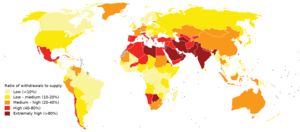Water Scarcity
Omi ki aña (ki ñọ chi ọbata omi abẹ ki iyañyi omi) chi am'i ut'ejugede Ẹñwu ekwu omi ẹfẹ ki at'eju álu k'amonẹ wewe atene . Omi aña lefu ọna ojoji meji. Oka efu ñwu chi ọna k'eju ali. Ẹkeji ñwu chi omi ki aña ọna economiki.[2]Éwn malábó:Rp Omi k'ama ọna ejugede chi ẹgba k'omi ma nana t'eju alu k'amonẹ ñeju ku ma du ch'ekwu jọn. Efu ñwu ñwọ che omi ku ma tene todu ki ecosystems kì ch'ukọlọ. Ami ewó ku ma ni desert climate an'iyanyi omi ègbá du.[3] Central Asia, West Asia, kpai North Africa chi ujiwe amì ewó lẹ. Omi aña lefu ọna economiki todu ki amẹñwu ekwu abẹki amẹñwu ki ya f'omi kwefu ají, aquifers, abẹki ugbo ojoji ojoji k'omi adufu kwó ma dẹn. Ila ñọ dufu ẹgba k'ukpayi amonẹ ma gbiti bọjọ alu kùma ñ'eju omi n.[2]Éwn malábó:Rp amonẹ wèwè efù Sub-Saharan Africa ad'eju kpáí ọbata omi eyì economiki.[4]Éwn malábó:Rp

Omi ẹfẹ ki defu ojanẹ wewe ñyọñyọ ki bọjọ ñwù amonẹ ku ma du chẹñwu du efu ọdọ wewe ki legwudu. Ugbo ele omi Kiya nyaramonè chitodu èkpayiló kidagbagba egba kpai ugbo kamonè atène omi, manyu Iko kpai ugbo komidè.[5] One of the main causes of the increase in global water demand is the increase in the number of people. Others are the rise in living conditions, changing diets (to more animal products),[6] and expansion of irrigated agriculture.[7][8] Climate change (including droughts or floods), deforestation, water pollution and wasteful use of water can also mean there is not enough water.[9] These variations in scarcity may also be a function of prevailing economic policy and planning approaches.
Water scarcity assessments look at many types of information. They include green water (soil moisture), water quality, environmental flow requirements, and virtual water trade.[6] Water stress is one parameter to measure water scarcity. It is useful in the context of Sustainable Development Goal 6.[10] Half a billion people live in areas with severe water scarcity throughout the year,[5][6] and around four billion people face severe water scarcity at least one month per year.[5][11] Half of the world's largest cities experience water scarcity.[11] There are 2.3 billion people who reside in nations with water scarcities (meaning less than 1700 m3 of water per person per year).[12][13][14]
There are different ways to reduce water scarcity. It can be done through supply and demand side management, cooperation between countries and water conservation. Expanding sources of usable water can help. Reusing wastewater and desalination are ways to do this. Others are reducing water pollution and changes to the virtual water trade.
- ↑ Ewn madú gbigalí kí manyó: Invalid
<ref>tag; no text was provided for refs named:15 - ↑ 2.0 2.1 Caretta, M.A., A. Mukherji, M. Arfanuzzaman, R.A. Betts, A. Gelfan, Y. Hirabayashi, T.K. Lissner, J. Liu, E. Lopez Gunn, R. Morgan, S. Mwanga, and S. Supratid, 2022: Chapter 4: Water. In: Climate Change 2022: Impacts, Adaptation and Vulnerability. Contribution of Working Group II to the Sixth Assessment Report of the Intergovernmental Panel on Climate Change [H.-O. Pörtner, D.C. Roberts, M. Tignor, E.S. Poloczanska, K. Mintenbeck, A. Alegría, M. Craig, S. Langsdorf, S. Löschke, V. Möller, A. Okem, B. Rama (eds.)]. Cambridge University Press, Cambridge, UK and New York, NY, USA, pp. 551–712, doi:10.1017/9781009325844.006.
- ↑ Rijsberman, Frank R. (2006). "Water scarcity: Fact or fiction?". Agricultural Water Management (in English). 80 (1–3): 5–22. Bibcode:2006AgWM...80....5R. doi:10.1016/j.agwat.2005.07.001.
- ↑ IWMI (2007) Water for Food, Water for Life: A Comprehensive Assessment of Water Management in Agriculture. London: Earthscan, and Colombo: International Water Management Institute.
- ↑ 5.0 5.1 5.2 Mekonnen, Mesfin M.; Hoekstra, Arjen Y. (2016). "Four billion people facing severe water scarcity". Science Water Stress Advances (in English). 2 (2): e1500323. Bibcode:2016SciA....2E0323M. doi:10.1126/sciadv.1500323. ISSN 2375-2548. PMC 4758739. PMID 26933676.
- ↑ 6.0 6.1 6.2 Liu, Junguo; Yang, Hong; Gosling, Simon N.; Kummu, Matti; Flörke, Martina; Pfister, Stephan; Hanasaki, Naota; Wada, Yoshihide; Zhang, Xinxin; Zheng, Chunmiao; Alcamo, Joseph (2017). "Water scarcity assessments in the past, present, and future: Review on Water Scarcity Assessment". Earth's Future (in English). 5 (6): 545–559. doi:10.1002/2016EF000518. PMC 6204262. PMID 30377623.
- ↑ Vorosmarty, C. J. (14 ochu ekebie 2000). "Global Water Resources: Vulnerability from Climate Change and Population Growth". Science. 289 (5477): 284–288. Bibcode:2000Sci...289..284V. doi:10.1126/science.289.5477.284. PMID 10894773. S2CID 37062764.
- ↑ Ercin, A. Ertug; Hoekstra, Arjen Y. (2014). "Water footprint scenarios for 2050: A global analysis". Environment International (in English). 64: 71–82. Bibcode:2014EnInt..64...71E. doi:10.1016/j.envint.2013.11.019. PMID 24374780.
- ↑ "Water Scarcity. Threats". WWF. 2013. Archived from the original on 21 ochu ekegwa 2013. Retrieved 20 ochu ekegwa 2013.
- ↑ Ewn madú gbigalí kí manyó: Invalid
<ref>tag; no text was provided for refs named:172 - ↑ 11.0 11.1 "How do we prevent today's water crisis becoming tomorrow's catastrophe?". World Economic Forum. 23 ochu eketa 2017. Archived from the original on 30 ochu ekegwe–eji 2017. Retrieved 30 ochu ekegwe–eji 2017.
{{cite web}}:|archive-date=/|archive-url=timestamp mismatch; 30 ochu ekegwe-eji 2017 suggested (help)CS1 maint: date format (link) - ↑ "Wastewater resource recovery can fix water insecurity and cut carbon emissions". European Investment Bank (in English). Retrieved 29 ochu ekejo 2022.
- ↑ "International Decade for Action 'Water for Life' 2005-2015. Focus Areas: Water scarcity". www.un.org (in English). Retrieved 29 ochu ekejo 2022.
- ↑ "THE STATE OF THE WORLD'S LAND AND WATER RESOURCES FOR FOOD AND AGRICULTURE" (PDF).